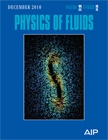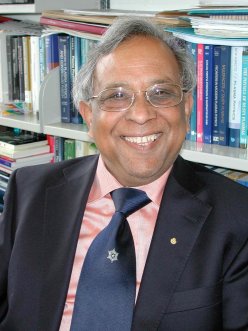
The American Institute of Physics (AIP) promotes science and the profession of physics, publishes physics journals, and produces publications for scientific and engineering societies. The AIP is made up of various member societies. Its corporate headquarters are at the American Center for Physics in College Park, Maryland, but the institute also has offices in Melville, New York, and Beijing.

Marshall Nicholas Rosenbluth was an American plasma physicist and member of the National Academy of Sciences, and member of the American Philosophical Society. In 1997 he was awarded the National Medal of Science for discoveries in controlled thermonuclear fusion, contributions to plasma physics, and work in computational statistical mechanics. He was also a recipient of the E.O. Lawrence Prize (1964), the Albert Einstein Award (1967), the James Clerk Maxwell Prize for Plasma Physics (1976), the Enrico Fermi Award (1985), and the Hannes Alfvén Prize (2002).

Physics of Fluids is a monthly peer-reviewed scientific journal covering fluid dynamics, established by the American Institute of Physics in 1958, and is published by AIP Publishing. The journal focus is the dynamics of gases, liquids, and complex or multiphase fluids—and the journal contains original research resulting from theoretical, computational, and experimental studies.

Liu Chen is an American theoretical physicist who has made original contributions to many aspects of plasma physics. He is known for the discoveries of kinetic Alfven waves, toroidal Alfven eigenmodes, and energetic particle modes; the theories of geomagnetic pulsations, Alfven wave heating, and fishbone oscillations, and the first formulation of nonlinear gyrokinetic equations. Chen retired from University of California, Irvine (UCI) in 2012, assuming the title professor emeritus of physics and astronomy.
Physics Letters was a scientific journal published from 1962 to 1966, when it split in two series now published by Elsevier:
IOP Publishing is the publishing company of the Institute of Physics. It provides publications through which scientific research is distributed worldwide, including journals, community websites, magazines, conference proceedings and books. The Institute of Physics is a scientific charity devoted to increasing the practice, understanding and application of physics. Any financial surplus earned by IOP Publishing goes to support physics through the activities of the Institute.

Plasma is one of four fundamental states of matter characterized by the presence of a significant portion of charged particles in any combination of ions or electrons. It is the most abundant form of ordinary matter in the universe, mostly in stars, but also dominating the rarefied intracluster medium and intergalactic medium. Plasma can be artificially generated, for example, by heating a neutral gas or subjecting it to a strong electromagnetic field.
Physical Review E is a peer-reviewed, scientific journal, published monthly by the American Physical Society. The main field of interest is collective phenomena of many-body systems. It is edited by Dario Corradini as of December 2024. While original research content requires subscription, editorials, news, and other non-research content is openly accessible.

Padma Kant Shukla was a distinguished Professor and first International Chair of the Physics and Astronomy Department of Ruhr-University Bochum in Germany. He was also the director of the International Centre for Advanced Studies in Physical Sciences at Ruhr-University Bochum. He held a PhD in physics from Banaras Hindu University in Varanasi, India and a second doctorate in Theoretical Plasma Physics from Umeå University in Sweden.
John Bryan Taylor is a British physicist known for his contributions to plasma physics and their application in the field of fusion energy. Notable among these is the development of the "Taylor state", describing a minimum-energy configuration that conserves magnetic helicity. Another development was his work on the ballooning transformation, which describes the motion of plasma in toroidal (donut) configurations, which are used in the fusion field. Taylor has also made contributions to the theory of the Earth's Dynamo, including the Taylor constraint.

The Plasmakristall-3 Plus laboratory was a joint Russian-German laboratory for the investigation of dusty/complex plasmas on board the International Space Station (ISS), with the principal investigators at the German Max Planck Institute for Extraterrestrial Physics and the Russian Institute for High Energy Densities. It was the successor to the PKE Nefedov experiment with improvements in hardware, diagnostics and software. The laboratory was launched in December 2005 and was operated for the first time in January 2006. It was used in 21 missions until it was deorbited in 2013. It is succeeded by the PK-4 Laboratory.
Miklos Porkolab (born March 24, 1939) is a Hungarian-American physicist specializing in plasma physics.
Harold Weitzner is an American applied mathematician and physicist whose primary research is plasma physics. He is Professor Emeritus of Mathematics at the Courant Institute of Mathematical Sciences and has served as Director of the Magneto-Fluid Dynamics Division at Courant since 1981, succeeding Harold Grad. He has published over 120 research articles on the topics of plasma physics, magnetohydrodynamics, fluid mechanics, fractional equations and kinetics, and chaos.
James F. Drake is an American theoretical physicist who specializes in plasma physics. He is known for his studies on plasma instabilities and magnetic reconnection for which he was awarded the 2010 James Clerk Maxwell Prize for Plasma Physics by the American Physical Society.
Ravindra Nath Sudan was an Indian-American electrical engineer and physicist who specialized in plasma physics. He was known for independently discovering the whistler instability in 1963, an instability which causes audible low-frequency radio waves to be emitted in the magnetosphere in the form of whistler waves. He also pioneered the study of the generation and propagation of intense ion beams, and contributed to theories of plasma instabilities and plasma turbulence.
Gregor Eugen Morfill is a German physicist who works in basic astrophysical research and deals with complex plasmas and plasma medicine.
Kunioki Mima is a Japanese plasma physicist. He is known for his contributions to the theory of turbulent transport in plasmas, and in particular the derivation of the Hasegawa–Mima equation in 1977, which won him the 2011 Hannes Alfvén Prize.

Subrata Roy is an Indian-born American inventor, educator, and scientist known for his work in plasma-based flow control and plasma-based self-sterilizing technology. He is a professor of Mechanical and Aerospace Engineering at the University of Florida and the founding director of the Applied Physics Research Group at the University of Florida. He is also the President and the founder of SurfPlasma Inc., a biotechnology company in Gainesville, Florida.
Patrick Henry Diamond is an American theoretical plasma physicist. He is currently a professor at the University of California, San Diego, and a director of the Fusion Theory Institute at the National Fusion Research Institute in Daejeon, South Korea, where the KSTAR Tokamak is operated.








